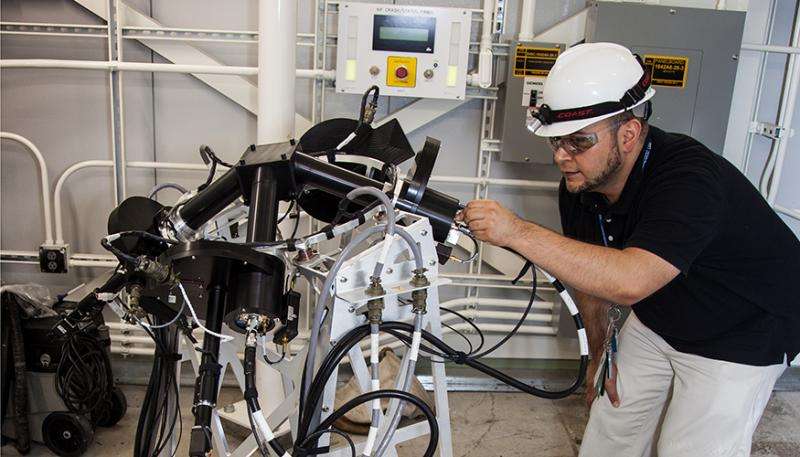Diagnostic provides top-down view of neutrons

A new diagnostic built on the National Ignition Facility's (NIF) roof is giving researchers a clearer picture of the neutrons released during laser-driven implosions of target capsules containing deuterium or deuterium and tritium (DT).
Instruments inside the North Pole neutron Time of Flight (nTOF) enclosure, a structure slightly larger than an industrial shipping container, detect and record neutron arrival times, providing researchers with much-needed data in the northern hemisphere of the NIF Target Chamber.
"It will give us a view of what we've been missing, and we believe a quieter one (with less interference) than what we've gotten so far," said NIF Co-Target Diagnostic Manager Mark Jackson.
The north pole system joins four other nTOF detectors—one located in the basement of the Target Bay (south pole), two on the Target Chamber equator, and one in the neutron alcove. The new nTOF is on the roof to provide a view of neutrons almost directly opposite from the south pole detector, enabling researchers to determine if the neutron source is moving coherently.
"The detectors in the nTOF measure the time of flight of the thermonuclear neutrons from the implosion to the detector, and so their velocity," said Joe Kilkenny, chief NIF experimentalist for measurements. "The north pole nTOF is close to opposite to NIF's south pole nTOF. Importantly, this allows the Doppler shift of the neutrons due to motion of the compressed plasma—like the pitch of a train's whistle changing as it approaches you and moves away from you—to be measured from the difference in the arrival times at the north and the south pole nTOFs."
As neutrons produced in the target chamber pass through the bibenzyl crystal housed in the North Pole nTOF enclosure, they induce scintillation light. The crystal's scintillation light is collected by a fast photo-detector which in turn produces a voltage in proportion to the number of passing neutrons. This voltage signal is then digitized every 100 picoseconds (a tenth of a billionth of a second), producing a high-fidelity record of the neutron flux passing through the detector.
The data collected by the devices will help researchers determine the shot's yield, as well as interesting properties of the plasma producing the neutrons, including its temperature and velocity. Understanding those properties motivated constructing the north pole system opposite the existing south pole system.
Construction crews began work on the enclosure last fall, cutting a 40-foot by 20-foot hole in the top of the NIF building down to the inner concrete ceiling of the facility. The precise alignment and the tricky angle of the three-inch-diameter line-of-sight flight path from target chamber center (TCC), projecting through a small hole in the floor of the structure, required an impressive feat of engineering. It also presented challenges from wind and seismic load, facility modification, and temperature control, Jackson said. About 30 LLNL employees worked on the project over the last year, about half of them from the Lab's engineering staff.
Behind the scintillators in the nTOF enclosure, preventing the neutrons from traveling further upward and outside the enclosure, is a three-foot thick concrete and steel block. The block is capable of fully stopping neutrons and photons, ensuring that any emissions are within the facility's safety limits and reducing the risk of outside radiation exposure to a negligible level.
The line-of-sight path is defined by a set of precision collimators that allow researchers to look at only the neutrons coming from the area around TCC.
To allow for more efficient operation, and to minimize the time NIF employees will have to be on the roof, the detector can be operated by remote control.
Not only is the newest detector a technological improvement over the others, said Perry Bell, NIF Co-Target Diagnostics manager, but the line of sight it affords is the best yet for researchers because there is limited mass around it to interfere with the measurement.
NIF has more than 70 diagnostics in all, and Bell said two more diagnostics similar to the North Pole nTOF will be built to extend the facility's diagnostic reach even further.
"These detectors will provide additional insight into fusion ignition and will represent key diagnostics for the NIF program," Bell added.
Provided by Lawrence Livermore National Laboratory




















